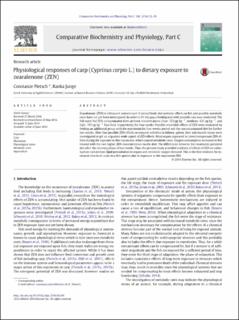Please use this identifier to cite or link to this item:
https://doi.org/10.21256/zhaw-1594| Publication type: | Article in scientific journal |
| Type of review: | Peer review (publication) |
| Title: | Physiological responses of carp (Cyprinus carpio L.) to dietary exposure to zearalenone (ZEN) |
| Authors: | Pietsch-Schmied, Constanze Junge, Ranka |
| DOI: | 10.21256/zhaw-1594 10.1016/j.cbpc.2016.06.004 |
| Published in: | Comparative Biochemistry and Physiology - Part C: Toxicology & Pharmacology |
| Volume(Issue): | 188 |
| Page(s): | 52 |
| Pages to: | 59 |
| Issue Date: | Oct-2016 |
| Publisher / Ed. Institution: | Elsevier |
| ISSN: | 1532-0456 |
| Language: | English |
| Subjects: | Mycotoxin; Physiological stress; Carp; Metabolic costs |
| Subject (DDC): | 572: Biochemistry |
| Abstract: | Zearalenone (ZEN) is a frequent contaminant of animal feeds, but systemic effects on fish and possible metabolic costs have not yet been investigated. In order to fill this gap a feeding trial with juvenile carp was conducted. The fish were fed ZEN-contaminated diets at three concentrations (low: 332 μg kg−1, medium: 621 μg kg−1, and high: 797 μg kg−1 final feed, respectively) for four weeks. Possible reversible effects of ZEN were evaluated by feeding an additional group with the mycotoxin for four weeks period and the uncontaminated diet for further two weeks. After that possible ZEN effects on enzyme activities in kidney, spleen, liver and muscle tissue were investigated to get an organism-wide aspect of ZEN effects. Most organs appeared to (over)compensate ZEN effects during the exposure to this mycotoxin, which caused metabolic costs. Oxygen consumption increased in fish treated with the two higher ZEN concentrations via the diet. The differences between the treatments persisted also after the recovery phase of two weeks. Thus, the present study provided evidence of effects of ZEN on carbohydrate metabolism, lipid peroxidation in organs and metabolic oxygen demand. This is the first evidence for increased metabolic costs in a fish species due to exposure to the mycotoxin ZEN. |
| URI: | https://digitalcollection.zhaw.ch/handle/11475/2354 |
| Fulltext version: | Published version |
| License (according to publishing contract): | Licence according to publishing contract |
| Departement: | Life Sciences and Facility Management |
| Organisational Unit: | Institute of Natural Resource Sciences (IUNR) |
| Appears in collections: | Publikationen Life Sciences und Facility Management |
Files in This Item:
| File | Description | Size | Format | |
|---|---|---|---|---|
| 2016_Pietsch-Schmied_Physiological responses of carp_Comparative Biochemistry and Physiology.pdf | 345.46 kB | Adobe PDF |  View/Open |
Show full item record
Pietsch-Schmied, C., & Junge, R. (2016). Physiological responses of carp (Cyprinus carpio L.) to dietary exposure to zearalenone (ZEN). Comparative Biochemistry and Physiology - Part C: Toxicology & Pharmacology, 188, 52–59. https://doi.org/10.21256/zhaw-1594
Pietsch-Schmied, C. and Junge, R. (2016) ‘Physiological responses of carp (Cyprinus carpio L.) to dietary exposure to zearalenone (ZEN)’, Comparative Biochemistry and Physiology - Part C: Toxicology & Pharmacology, 188, pp. 52–59. Available at: https://doi.org/10.21256/zhaw-1594.
C. Pietsch-Schmied and R. Junge, “Physiological responses of carp (Cyprinus carpio L.) to dietary exposure to zearalenone (ZEN),” Comparative Biochemistry and Physiology - Part C: Toxicology & Pharmacology, vol. 188, pp. 52–59, Oct. 2016, doi: 10.21256/zhaw-1594.
PIETSCH-SCHMIED, Constanze und Ranka JUNGE, 2016. Physiological responses of carp (Cyprinus carpio L.) to dietary exposure to zearalenone (ZEN). Comparative Biochemistry and Physiology - Part C: Toxicology & Pharmacology. Oktober 2016. Bd. 188, S. 52–59. DOI 10.21256/zhaw-1594
Pietsch-Schmied, Constanze, and Ranka Junge. 2016. “Physiological Responses of Carp (Cyprinus Carpio L.) To Dietary Exposure to Zearalenone (ZEN).” Comparative Biochemistry and Physiology - Part C: Toxicology & Pharmacology 188 (October): 52–59. https://doi.org/10.21256/zhaw-1594.
Pietsch-Schmied, Constanze, and Ranka Junge. “Physiological Responses of Carp (Cyprinus Carpio L.) To Dietary Exposure to Zearalenone (ZEN).” Comparative Biochemistry and Physiology - Part C: Toxicology & Pharmacology, vol. 188, Oct. 2016, pp. 52–59, https://doi.org/10.21256/zhaw-1594.
Items in DSpace are protected by copyright, with all rights reserved, unless otherwise indicated.